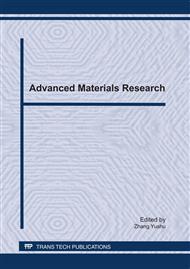[1]
C.T. Sims, N.S. Stoloff and W.C. Hagel, Superalloys II- High Temperature Materials for Aerospace and Industrial Power, John Wiley & Sons Inc., New York, NY, USA (1987).
DOI: 10.1080/10426919208947432
Google Scholar
[2]
Y.M. Yaman, M.C. Kushan, Hot Cracking Susceptibilities In the Heat Affected Zone of Electron Beam Welded Inconel 718, Journal of Materials Science Letters 17, 1231-1234 (1998).
Google Scholar
[3]
E.A. Otti, J. Grohi and H. Sizek, Metals Affordability Initiative: Application of Allvac Alloy 718Plus for Aircraft Engine Static Structural Components, Superalloys 718, 625, 706 and Derivatives (2005).
DOI: 10.7449/2005/superalloys_2005_35_45
Google Scholar
[4]
B.J. Bond and R.L. Kennedy, Evaluation of ALLVAC 718 plus Alloy In the Cold Worked and Heat Treated Condition, Superalloys 718, 625, 706 and Derivatives (2005).
DOI: 10.7449/2005/superalloys_2005_203_211
Google Scholar
[5]
K. Schreiber, K. Loehnert, R.F. Singer, Opportunities and Challenges for the New Nickel-Based Alloy 718 Plus, II. Symposium on Recent Advantages of Nb-Containing Materials in Europe (2006).
Google Scholar
[6]
W. Cao, Solidification and Solid State Phase Transformation of ALLVAC 718 Plus Alloy, Superalloys 718, 625, 706 and Derivatives 2005, TMS, (2005).
DOI: 10.7449/2005/superalloys_2005_165_177
Google Scholar
[7]
W. Cao and R. Kennedy, Role of Chemistry in 718-Type Alloys- Alloy 718 plus Development, Edited by K.A. Green, T.M. Pollock, H. Harada T.E. Howson, R.C. Reed, J.J. Schirra, and S, Walston, Superalloys, TMS (The Minerals, Metals & Materials Society) (2004).
DOI: 10.7449/2004/superalloys_2004_91_99
Google Scholar
[8]
K.R. Vishwakarma, N.L. Richards, M.C. Chaturvedi, Microstructural Analysis of Fusion and Heat Affected Zones in Electron Beam Welded ALLVAC® 718PLUSTM superalloy, Materials Science and Engineering A 480 (2008) 517–528 (2007).
DOI: 10.1016/j.msea.2007.08.002
Google Scholar
[9]
K.R. Vishwakarma and M.C. Chaturvedi, A Study Of Haz Mıcrofıssurıng In A Newly Developed Allvac® 718 Plus Tm Superalloy.
DOI: 10.7449/2008/superalloys_2008_241_250
Google Scholar
[10]
R. A. Jeniski, Jr. and R. L. Kennedy, Development of ATI Allvac 718Plus Alloy and Applications, II. Symposium on Recent Advantages of Nb-Containing Materials in Europe (2006).
Google Scholar
[11]
X. Liu, J. Xu, N. Deem, K. Chang, E. Barbero, W. Cao, R. L. Kennedy, T. Carneiro, Effect Of Thermal-Mechanıcal Treatment On The Fatigue Crack Propagatıon Behavıor Of Newly Developed Allvac 718plus Alloy, Superalloys 718, 625, 706 and Derivatives 2005, TMS, (2005).
DOI: 10.7449/2005/superalloys_2005_233_242
Google Scholar
[12]
X. Liu, S. Rangararan, E. Barbero, K. Chang, W. Cao, R. Kennedy and T. Carneiro, Fatigue Crack Propagatıon Behavıors Of New Developed Allvac 718plus Superalloy, Superalloys 2004, TMS (2004).
DOI: 10.7449/2001/superalloys_2001_283_290
Google Scholar
[13]
R. L. Kennedy, Allvac® 718plus™, Superalloy For The Next Forty Years, Superalloys 718, 625, 706 and Derivatives 2005, TMS, (2005).
DOI: 10.7449/2005/superalloys_2005_1_14
Google Scholar


